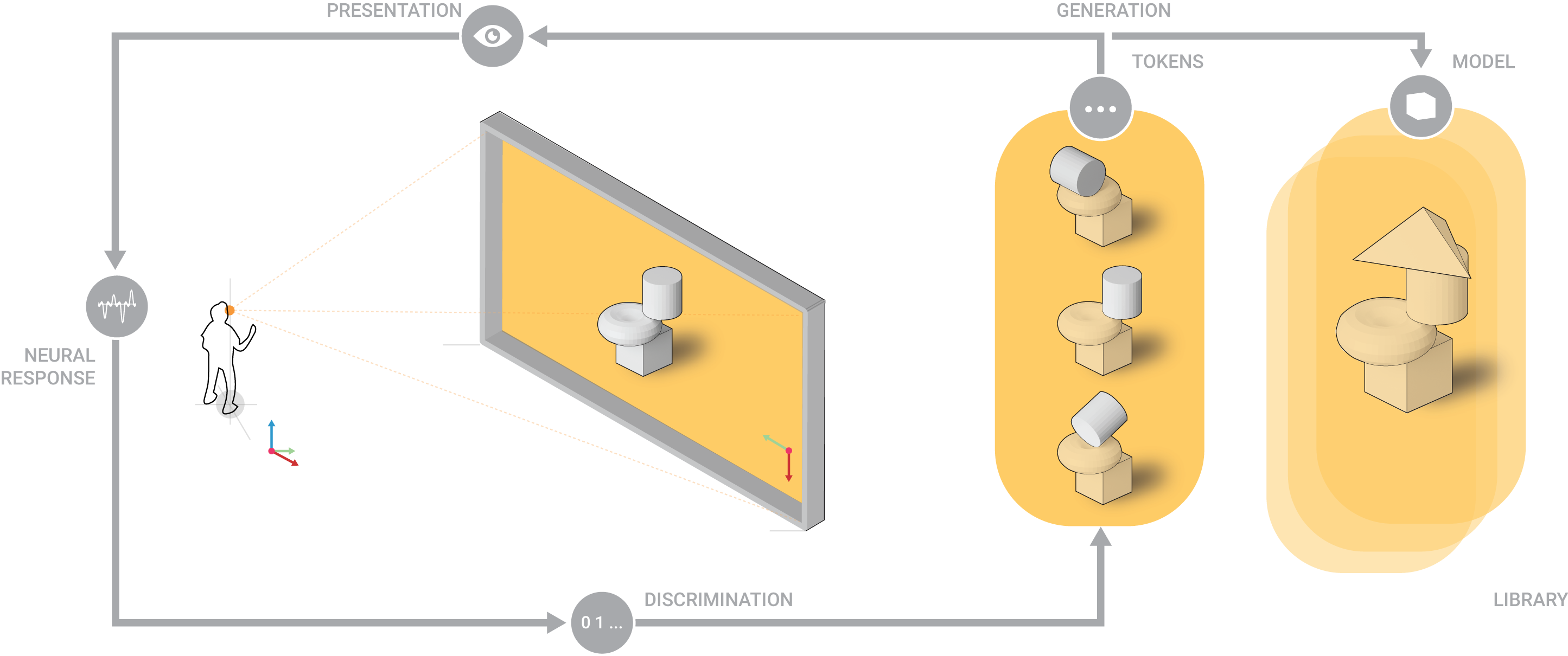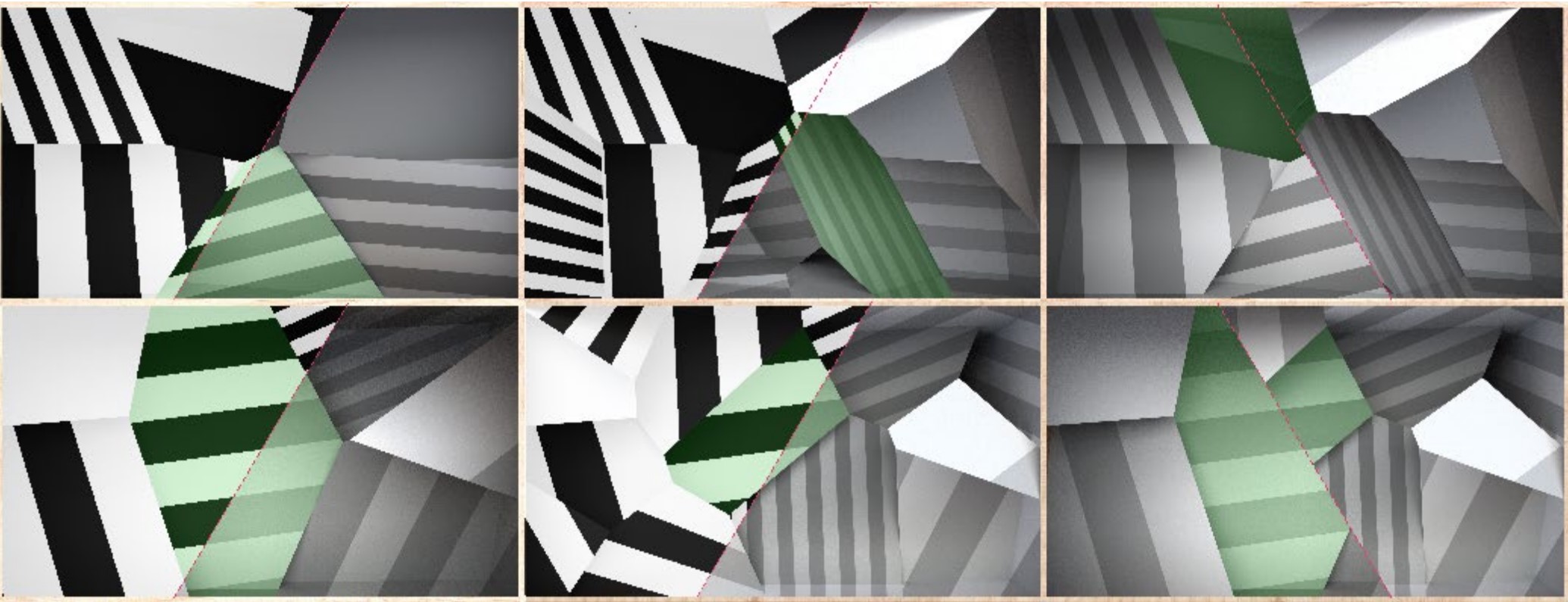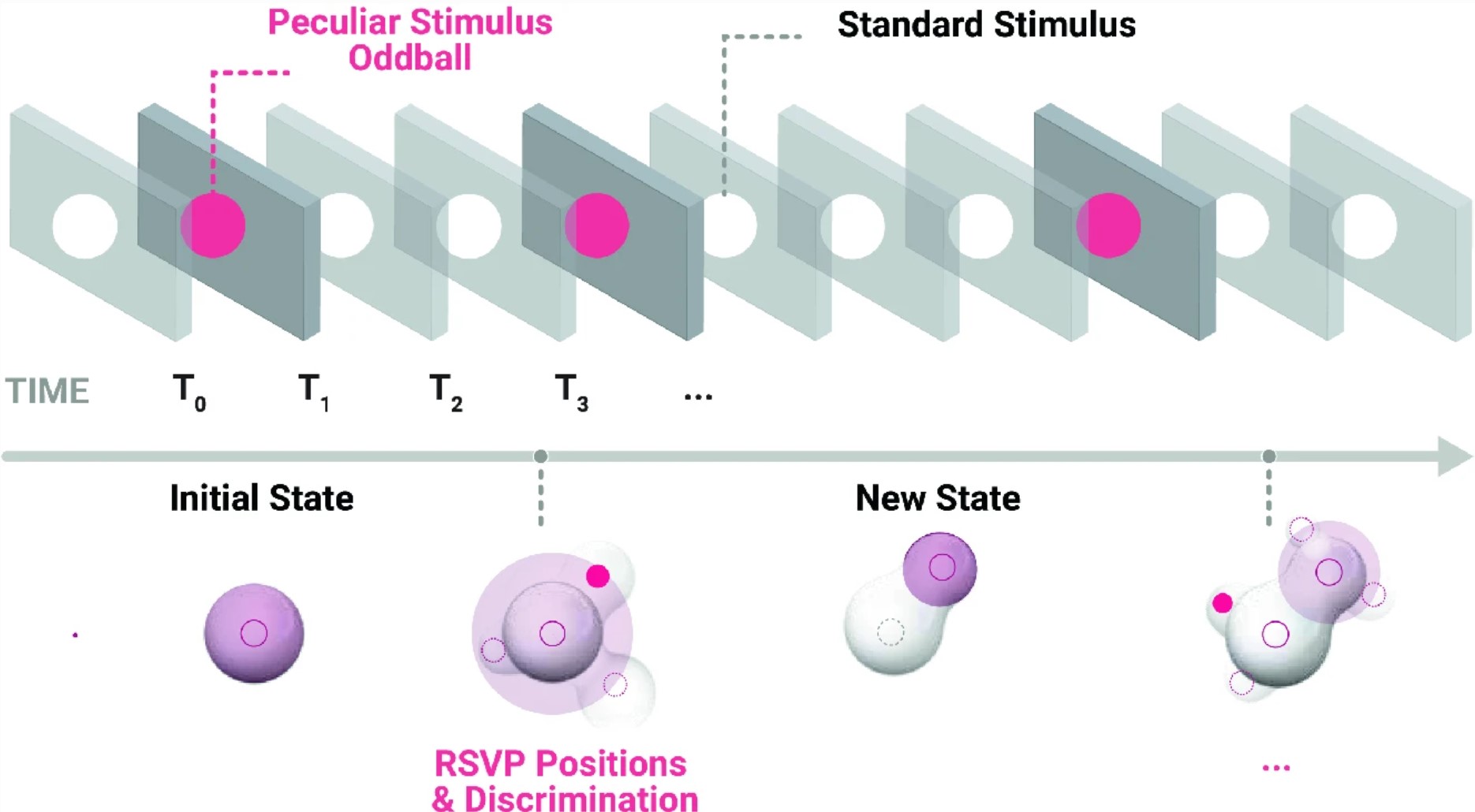Publications
Contributions as Book Chapters, Journal Publications, and Proceedings will be listed here as soon preprints are made available online.
Books
Book chapters and full contributions will be listed here as soon as preprints are made available online.
The Hypothesis of Greater Variance, or Why Considering Covert Responses in Human-Computer Interactions
Cutellic P. - in Brain Art, ed. Nijholt A., Springer 2023
Coming soon…

Interactive and Generative modeling loop. Neuramod.
Journals
Journal contributions for work-in-progress and full papers will be listed here as soon as preprints are made available online.
Study Protocol for Randomized Trials on Visual ERP for multiclass discrimination in CAAD applications
Cutellic P., Qureshi N.K. - in BMC Trials, 2022 (Work-In-Progress)
The proposed study aims to observe the detection of Event-Related Potentials’ components and correlated neural phenomena under the visual presentation of complex stimuli and devise processing methods that would generalize their classification for applications in Computer-Aided Architectural Design, where visual complexity becomes an intrinsic feature of the tasks. It aims to investigate the cardinality of discriminative neural patterns correlated with the presentation of complex visual stimuli by detecting subcomponents of these neural phenomena using the designed system on short and prolonged periods of time and involving participants from architecture, visual arts or related fields. Subsequent results will bring to further discussion the role of visual experience in such system and the range it might address in the population segment.

Interactive and Generative modeling loop. Neuramod.
Proceedings
Contributions to Conferences and Symposium Proceedings will be listed here as soon as preprints are made available online.
An Inverse Modeling Method to Estimate Uncertain Spatial Configurations From 2D Information and Time-Based Visual Discriminations
Cutellic P. - in Proceedings of Design Modelling Symposium, Berlin, 2022 (Full Paper)

Interactive and Generative modeling loop. Neuramod.
Growing Shapes with a Generalised Model from Neural Correlates of Visual Discrimination
Cutellic P, Khalid Qureshi N., in Proceedings of the 2020 DigitalFUTURES, Singapore, 2021 (Full Paper)
This paper focuses on the application of visual Event-Related Potentials (ERP) in better generalisations for design and architectural modelling. It makes use of previously built techniques and trained models on EEG signals of a singular individual and observes the robustness of advanced classification models to initiate the development of presentation and classification techniques for enriched visual environments by developing an iterative and generative design process of growing shapes. The pursued interest is to observe if visual ERP as correlates of visual discrimination can hold in structurally similar, but semantically different, experiments and support the discrimination of meaningful design solutions. Following bayesian terms, we will coin this endeavour a Design Belief and elaborate a method to explore and exploit such features decoded from human visual cognition.

Interactive and Generative modeling loop. Neuramod.
Courses
Academic obligatory and elective courses.
Architecture and its Cognition, Architectonics From The Mind.
CAAD Theory, Elective course Bc./Ms., Autumn semester 2024, Dr. Sc. P. Cutellic
If architecture aims to produce signification by articulating things together, where is such signification emerging from, and how? From a thing-in-the-world to an object-in-the-mind, to an object- in-the-world. This is the path the course will follow to introduce and discuss important research about human perception, cognition, and the capacity to make sense of the world and eventually act upon it. Such a path has been observed and questioned throughout centuries of human history and technological innovation and offers great potential for the near future of architecture. What questions and ideas emerged from that position in the worlds of arts, humanities, and science? What is at stake in digital industries, and what are the active research topics? Does it challenge the way we approach and experience architecture and its tasks? The course will start with these questions to depict in broad strokes the richness of ideas architecture and its cognition may offer.

Left: Friedrich Kiesler, Arch as a Rainbow of Shells, 1960–1965. The Estate of Frederick Kiesler, New York © Österreichische Friedrich und Lillian Kiesler-Privatstiftung, Wien. Right: The Finitorium. Leon Battista Alberti, De Statua, 1536.
Las Meninas, Las Vegas and Two Crises
Dr. Sc. Pierre Cutellic, ETH, 23.09.2024
This first course introduces students to the fundamentals of architectonics, framed within the crisis of meaning that dominated architectural thought in the second half of the 20th century. Surprisingly, the same concerns surfaced across the sciences, leading to the so-called cognitive crisis—a profound questioning of how meaning is constructed yet largely ignored in architecture. By drawing from these parallel intellectual movements, the course will provoke a deeper exploration of how things come to sense, connecting these vast ideas back to architecture. As a point of departure, the question leading the reflection from a human-centred perspective will be how architecture can now deal with and make sense of the world. The journey begins with a striking lesson drawn from a baroque masterpiece of the 17th century, opening new perspectives on architectural meaning and its reticulations.
Course Material:
– Things and Places, Zenon Pylyshyn, MIT Press, 2007
– Machine Learning From Las Vegas, Pierre Cutellic, Volume, 49, 2016
– Neurodesign: Modeling from Neural Potentials, Pierre Cutellic, ETH, 2022
– on Grammar and Rhetoric, Peter Eisenman, AA, 2010
Surroundings and Their Perception
Guest Speaker: Prof. Dr. Chris Salter, ZHdK, 14.10.2024
This course session delves into the concept of architectural surroundings as proposed by the architect/artist duo Madeline Gins and Arakawa, and seen from the lens of contemporary interactive and immersive media arts. Their radical approach reimagines architecture as a dynamic, interactive force that must actively stimulate and engage its occupants, rather than merely providing a static, passive environment. The duo’s vision, which grew out of 20th-century experimental architecture, emphasizes the need for continuous interaction between humans and their surroundings, proposing that architecture can shape consciousness by surrounding individuals with sensory-rich stimuli that encourage participation and immersion. This session explores how architecture can afford such interaction and questions its capacity to foster an immersive environment that enhances spatial awareness and sensory engagement. Through the lens of Gins and Arakawa’s work, students will critically assess the degree to which architecture is responsible for actively surrounding and involving human beings in sensory experiences that enrich environmental understanding. The discussion leads to a broader inquiry: what is the necessary reciprocal involvement of humans and their architectural surroundings in establishing meaningful immersion? By considering these ideas, students will explore the limits and potential of architecture as an active agent in shaping both individual perception and collective experience within the built environment.
Course Material:
– Architectural Surrounds, Gins and Arakawa, University Alabama Press, 2002
– Sensing Machines, Chris Salter, MIT Press, upcoming
Empirical and Embodied Aesthetics Perspectives
Guest Speaker: Prof. Dr. Emily S. Cross, ETH, 04.11.2024
Course Material to be changed:
– Architectural Surrounds, Gins and Arakawa, University Alabama Press, 2002
– Sensing Machines, Chris Salter, MIT Press, upcoming
Empirical and Embodied Aesthetics Perspectives
Guest Speaker: Ass. Prof. Dr. Zakaria Djebbara, AAU, 02.12.2024
Course Material to be changed:
– Architectural Surrounds, Gins and Arakawa, University Alabama Press, 2002
– Sensing Machines, Chris Salter, MIT Press, upcoming
Getting Lost in Buildings
Guest Speaker: Prof. Dr. Christoph Hoelscher, ETH, 30.09.2024
Course Material:
– Whence and Whither, Philip Johnson, MIT Press, 1965
– Getting Lost in Buildings, Carlson et. al, 2010
Architectonics from Artificial Minds
Guest Speaker: Ass. Prof. Dr. Immanuel Koh, SUTD, 28.10.2024
This session explores the frontiers of generative AI in architecture, introducing students to some of the latest research trends in machine learning’s creative applications. Immanuel Koh delves into the evolving role of AI models, examining their potential to both complement and challenge human creativity in the architectural design process. By showcasing recent advancements, he highlights AI’s ability to generate, evaluate, and adapt complex forms and spatial concepts, inviting an investigation into how these technologies might expand architects’ creative boundaries. Central to this discussion is a probing question: how might human intelligence and AI’s capacities intersect, interact, and even emulate one another? It suggests a future where AI not only assists in repetitive or technical tasks but actively participates in creative ideation, bringing a collaborative intelligence to architectural design. By combining human intuition with machine precision, the presentation hints at a transformative shift, one that holds the promise of discovering new architectural vocabularies and exploring spaces previously unimagined, all while remaining critically aware of each entity’s unique capabilities and constraints.
Course Material to be changed:
– Whence and Whither, Philip Johnson, MIT Press, 1965
– Getting Lost in Buildings, Carlson et. al, 2010
Effects of Biophilic Design on Emotions, Cognition and Neurophysiology
Guest Speaker: Dr. Julie Milovanovic, UNCC, 11.11.2024
Julie Milovanevic, an architect and researcher at UNCC specializing in design cognition, education, and sustainable design, presents her findings on biophilic design’s impact on well-being. Rooted in our innate biological and genetic connections to nature, her research investigates the psychophysiological effects of exposure to natural elements within the built environment. The presentation explores two experimental studies assessing cognitive and neurophysiological responses to biophilic design. In one study, design students worked in a space featuring an algae façade, allowing for analysis of their performance and engagement. The second study measured participants’ reactions to images containing biophilic elements, using tools such as eye trackers and functional near-infrared spectroscopy (fNIRS). These methods provided objective data on how natural elements in spaces affect perception, cognition, and emotional well-being. By blending subjective evaluations with empirical measurements, Milovanevic sheds light on the challenges of quantifying which biophilic features most effectively support health and productivity. Her research underscores the importance of integrating nature into architectural design to create environments that foster physical and mental wellness, offering new pathways for sustainable and health-conscious design practices. Extrapolating from this body of work, one might raise critical questions: To what extent does conceptual biophilic content influence the mind? And is biophilia a feature-wise or object-wise principle?
Course Material to be changed:
– Whence and Whither, Philip Johnson, MIT Press, 1965
– Getting Lost in Buildings, Carlson et. al, 2010
The Value of Values
Guest Speaker: Prof. Dr. Maurice Benayoun, NJU, 07.10.2024
Course Material:
– Art in The Age of Virtuality, Maurice Benayoun, Medium, 2024
Structuring Experience:
Guest Speaker: Dr. Kristine Mun, ANFA, 18.11.2024
In this presentation, Kris Mun delves into the pioneering work of Lars Spuybroek and his architectural office, NOX, a pivotal reference in late 20th-century architectural discourse. Mun examines how NOX reappraised phenomenology, integrating it into computational design strategies to redefine the role of the architectural surface as enactive and dynamic in its engagement with life activities. Through a close analysis of NOX’s projects, the talk addresses the challenges architecture faces in systematically accommodating life, questioning how design can evolve to remain relevant to human existence. To what extent can designers meaningfully converse with the human mind through the physical environment? How can architectural forms support life without becoming rigidly overfitted systems? The discussion underscores the need for strategies that balance systemic rigor with adaptability, ensuring architecture’s vitality in the face of changing human needs and environmental complexities. By revisiting Spuybroek’s work, the presentation highlights the potential of computational and phenomenological approaches to redefine architecture’s relevance in a broader ecological and existential context. Mun invites designers to think beyond mere form-making, proposing a thoughtful recalibration of architectural processes to sustain human activities and foster meaningful interactions between people and their environments
Course Material to be changed:
– Art in The Age of Virtuality, Maurice Benayoun, Medium, 2024
'Neurons, Simulated Intelligences' at Centre Pompidou, Feedback on An Exhibition
Guest Speaker: Camille Lenglois, CNAC, 25.11.2024
Camille Lenglois presents an engaging overview of the ‘Neurons, Simulated Intelligences’ exhibition, hosted by the Centre Pompidou from February 26 to April 20, 2020. Part of the fourth edition of the ‘Mutations / Creations’ series, this groundbreaking exhibition contextualized artificial intelligence within the broader history of neuroscience and neurocomputing. It explored the interplay between art, science, and technology, offering a comprehensive panorama of human curiosity about the mind and the evolution of intelligence. Organized into five thematic areas, the exhibition wove together historical and contemporary research across disciplines. Graphical representations traced connections between artistic practices—encompassing architecture, design, and music—and advancements in science and industry. By integrating diverse perspectives, it illuminated the shared pursuit of understanding and modeling the complexities of human cognition. Lenglois highlights how this exhibition underscores the symbiotic relationship between innovation and creativity. From early neurocomputing concepts to modern explorations of artificial intelligence, the presentation celebrates the cross-pollination of ideas between artists and scientists. This rich dialogue not only reflects historical paradigms but also inspires new ways of thinking about intelligence in the age of AI, fostering a deeper appreciation for the convergence of disciplines in shaping the future.
Course Material to be changed:
– Art in The Age of Virtuality, Maurice Benayoun, Medium, 2024
COMING SOON